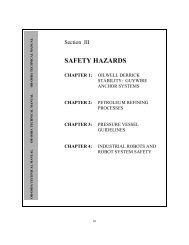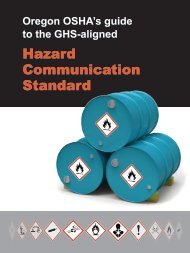Asbestos - Rules of Abatement - Oregon OSHA
Asbestos - Rules of Abatement - Oregon OSHA
Asbestos - Rules of Abatement - Oregon OSHA
Create successful ePaper yourself
Turn your PDF publications into a flip-book with our unique Google optimized e-Paper software.
<strong>Oregon</strong> <strong>OSHA</strong>’s asbestos standard established specific work<br />
practices for each class <strong>of</strong> asbestos work in construction.<br />
Class I work<br />
A designated competent person must supervise all Class I work, including<br />
installing and operating the control system. The DEQ-licensed supervisor must<br />
be on site if more than three linear feet <strong>of</strong> material is removed. Employers must<br />
place barriers over all openings to regulated areas or use another barrier or<br />
isolation method to prevent airborne asbestos from migrating for the following:<br />
• Class I jobs removing more than 25 linear feet or 10 square feet <strong>of</strong><br />
thermal insulation or surfacing material<br />
• Other Class I jobs without negative exposure assessments<br />
• Areas adjacent to a Class I regulated area where employees are working<br />
Otherwise, employers must perform perimeter-area surveillance during each<br />
work shift. No asbestos dust should be visible. Perimeter monitoring must show<br />
that clearance levels are met (as contained in 40 CFR 763, Subpart E <strong>of</strong> the<br />
“EPA <strong>Asbestos</strong> in Schools” rule) or that perimeter-area levels are not higher<br />
than background levels.<br />
For all Class I jobs:<br />
22<br />
• HVAC systems must be isolated in the regulated area by sealing with a<br />
double layer <strong>of</strong> 6-mil plastic or the equivalent.<br />
• Impermeable drop cloths must be placed on surfaces beneath all removal<br />
activity.<br />
• All objects within the regulated area must be covered with secured<br />
Impermeable drop cloths or plastic sheeting.<br />
• For jobs without a negative exposure assessment or where exposure<br />
monitoring shows the PEL is exceeded, employers must ventilate the<br />
regulated area to move the contaminated air away from the employee<br />
breathing zone and toward a HEPA filtration or collection device.<br />
DEQ/LRAPA will not allow alternatives to the negative pressure<br />
enclosure requirements for removing friable asbestos material.<br />
In addition, employees performing Class I work must use one or more <strong>of</strong> the<br />
following control methods (For the specifications, limitations, and recommended<br />
work practices <strong>of</strong> these required control methods, refer to Occupational<br />
Exposure to <strong>Asbestos</strong>, OAR 437-003-1926.1101):<br />
• Negative-pressure enclosure systems must be used when the configuration<br />
<strong>of</strong> the work area makes it impossible to erect an enclosure.<br />
• Glove bag systems can be used to remove asbestos-containing or<br />
presumed asbestos-containing materials from straight runs <strong>of</strong> piping.<br />
• Negative-pressure glove bag systems can be used to remove asbestoscontaining<br />
or presumed asbestos-containing materials from piping.<br />
• Negative-pressure glove box systems can be used to remove asbestoscontaining<br />
or presumed asbestos-containing materials from pipe runs.
















